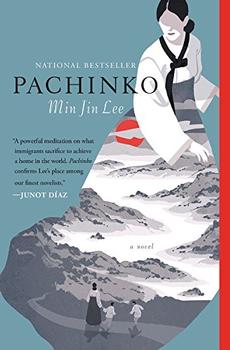Summary | Excerpt | Reading Guide | Reviews | Beyond the Book | Read-Alikes | Genres & Themes | Author Bio

This article relates to Pachinko
"If you are a rich Korean, there's a pachinko parlor in your background somewhere," Min Jin Lee writes in her novel Pachinko. Several of her Korean characters end up working in pachinko parlors, despite their differing levels of education and their previous experience.
Pachinko is essentially an upright pinball machine. Gamblers pay to borrow a set of small steel balls that are loaded into the contraption. Pressing a spring-loaded handle launches them onto a metal track lined with brass pins and several cups. The aim is to bounce the balls off the pins and get them to land in the cups before they fall down the hole at the bottom. A ball landing in a cup triggers a payout, in the form of extra balls dropping into the tray at the front. Officially, there is no monetary payout because gambling for cash was until recently illegal in Japan; instead, balls are exchanged for tokens or small prizes like pens or chocolate bars, or more balls. Usually though, there is a storefront near the pachinko parlor where the tokens can be exchanged for cash or grocery vouchers.
 First invented in Japan in the 1920s, pachinko became popular after the end of World War II. By the 1980s fully mechanical machines were starting to be replaced by ones that incorporate electronic features, such as an animated screen. In 2002 it was estimated that 30 million Japanese play pachinko on a regular basis, spending $200 billion a year. Gambling addiction is a perennial and serious concern. A 2011 CNN Travel article certainly makes a pachinko parlor sound like a hypnotic atmosphere:
First invented in Japan in the 1920s, pachinko became popular after the end of World War II. By the 1980s fully mechanical machines were starting to be replaced by ones that incorporate electronic features, such as an animated screen. In 2002 it was estimated that 30 million Japanese play pachinko on a regular basis, spending $200 billion a year. Gambling addiction is a perennial and serious concern. A 2011 CNN Travel article certainly makes a pachinko parlor sound like a hypnotic atmosphere:
Entering one of these ubiquitous gambling establishments for the first time is like stumbling upon another dimension. A non-stop barrage of loud, futuristic zaps and pings greets you through a fluorescent haze, fogged with clouds of cigarette smoke. Narrow aisles are lined with row after row of near-identical game machines that players sit facing, side-by-side and back-to-back for hours on end.
Because of the air of near-illegality that surrounds pachinko, it has been viewed as one of the few acceptable professions for Koreans living in Japan. "It has long been considered a dirty business, and so run by those on the edge of society. For this reason, Korean ownership of pachinko parlors is common," an article on JapanVisitor.com explains.
In the twenty-first century, pachinko has been in decline for two major reasons. One is the Japanese government's intention to open casinos (casino gambling was legalized in December 2016). The other is pachinko's fusty image. Young people raised on video games are likely to see it as an old-fashioned activity for the previous generation. The industry has responded by trying to spruce up pachinko parlors, making them cleaner and in some cases smoke-free. There are also new electronic elements to the machines that are meant to mimic features of online gaming.
It remains to be seen whether pachinko, for many decades a legal gray area, will survive in Japan's new era of legalized gambling.
See this Guardian gallery of photos from pachinko parlors.
Click on the video below to see a game of Pachinko in action:
Picture of Japanese Pachinko parlor by Tischbeinahe
Filed under Cultural Curiosities
![]() This "beyond the book article" relates to Pachinko. It originally ran in February 2017 and has been updated for the
November 2017 paperback edition.
Go to magazine.
This "beyond the book article" relates to Pachinko. It originally ran in February 2017 and has been updated for the
November 2017 paperback edition.
Go to magazine.
Your guide toexceptional books
BookBrowse seeks out and recommends the best in contemporary fiction and nonfiction—books that not only engage and entertain but also deepen our understanding of ourselves and the world around us.